冀教版七年级英语下册Lesson18课教案
- 格式:ppt
- 大小:859.50 KB
- 文档页数:15

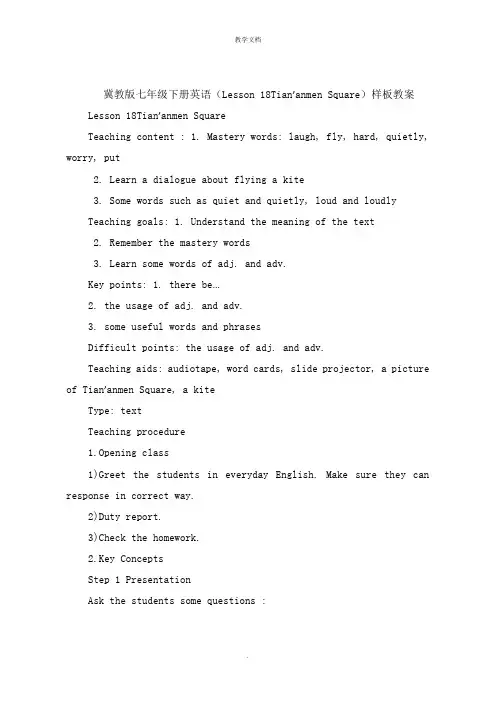
冀教版七年级下册英语(Lesson 18Tian’anmen Square)样板教案Lesson 18Tian’anmen SquareTeaching content : 1. Mastery words: laugh, fly, hard, quietly, worry, put2. Learn a dialogue about flying a kite3. Some words such as quiet and quietly, loud and loudlyTeaching goals: 1. Understand the meaning of the text2. Remember the mastery words3. Learn some words of adj. and adv.Key points: 1. there be…2. the usage of adj. and adv.3. some useful words and phrasesDifficult points: the usage of adj. and adv.Teaching aids: audiotape, word cards, slide projector, a picture of Tian’anmen Square, a kiteType: textTeaching procedure1.Opening class1)Greet the students in everyday English. Make sure they can response in correct way.2)Duty report.3)Check the homework.2.Key ConceptsStep 1 PresentationAsk the students some questions :Have you ever visited Tian’anmen Square If yes, when If no, why not Do you want to visit Tian’anmen Square Why or why notYou may give them some words to help them.Step 2 Listen, answer and analyzeListen to the tape with the following questions:What happens to Danny?Can Jenny fly a kiteCan Danny fly a kiteAnswer the questions together with the students and then discuss the text again. If they have any question, explain to them. Deal with the language points at the same time. Pay attention to the usage of loud and loudly, quiet and quietly.Step 3 Listen, read and actListen to the audiotape again and let the students read after it. Give them a few minutes to practice the text. Correct the pronunciation when necessary. Then have them act out the text in roles.Step 4 PracticeDivide the class into small groups. Ask each group to make up a dialogue about walking on Tian’anmen Square. Encourage the students to use as much vocabulary as possible from this unit (easy, hard, loudly, quietly, many, men, women, children, people). Encourage the students to be active and praise them for talking risks with English! The more they experiment, the more they learn.Step 5 Deal with “LET’S DO IT〞Work with a partner. Draw a map of Tian’anmen Square. Describe your maps to each other. What are the people doing Try to use loudly, quietly,slowly and quickly.Step 6 Consolidation1. Translation1) 放风筝_____________ 2) 玩得痛快__________ 3) 天安门__________4) 看见某人放风筝 _________ 4) hurt one’s arm _________5) Let’s do sth. ___________ 6) laugh at _________2. Fill in the blanks with the correct forms of the words given.1〕We often see boys ________ football. (play)2) Tom is a ____ boy. He doesn’t like to talk with others. (quietly)3) The street is so busy, but the people walk ______ (happy)4) I can’t hear your words, will you please speak ________ (loud)5) Let’s _______ the basket on the table. (put)Step 7 If there is enough time, do the exercises in activity book.Step 8 SummaryToday we learn a text about Li Ming and his friends. They are flying kites. There are so many people on Tian’anmen Square. Some people are loud and some are quiet. After class you should understand the meaning of the text and try to use loud, loudly, quiet, quietly correctly.3.Homework1)Understand the meaning of the text2)Remember the mastery words3)Finish the activity book in lesson 18。
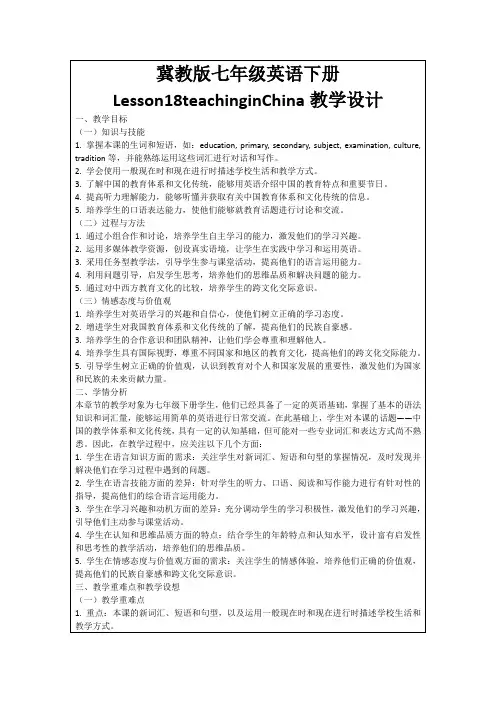

英语初一下冀教版18课教学三案PartoneTeachingPlan三维目标:知识与能力:1.Understandthemeaningofthetext.2.Rememberthemasterywordsinthislesson.3.FindandusethelistmasteryvocabularyinLesson18过程与方法:学生自主学习,完成既定目标情感态度价值观:培养学生及时适应环境的能力教学重难点:Mainpoints:1.therebe…2.theusageofadj.andadv.3.someusefulwordsandphrasesDifficultpoints:theusageofadj.andadv.Teachingprocedures:1.Warmingup1)GreetingsineverydayEnglish.2)DutyreportTheycansayanythingtheyliketosay.3)Mainlyrevisionoflastlesson2.NewlessonStep1.LeadinDiscussthequestionsin“THINKABOUTIT”HaveyouevervisitedTian’anmenSquare?Ifyes,when?Ifno,whynot? DoyouwanttovisitTian’anmenSquare?Whyorwhynot? Letthestudentslearntoexpressthemselvesfreely.Step2.Listentothetapewiththefollowingquestions. Listentotapewiththefollowingquestions:WhathappenstoDanny?CanJennyflyakite?CanDannyflyakite? Answerthequestionstogetherwiththestudentsandthendiscussthetextagain.I ftheyhaveanyquestion,explaintothem.Dealwiththelanguagepointsatthesame time.Payattentiontotheusageofloudandloudly,quietandquietly.Step4.Havethemreadthetextforafewminutesandthenaskthemtoactoutthedialo gueinroles.Step5.Practice:Dividetheclassintosmallgroups.Askeachgrouptomakeupadialogueaboutwalki ngonTian’anmenSquare.Encouragethestudentstouseasmuchvocabularyaspossiblefromth isunit(easy,hard,loudly,quietly,many,men,women,children,people).EncouragethestudentstobeactiveandpraisethemfortalkingriskswithEnglish!Them oretheyexperiment,themoretheylearn.LET’SDOITWorkwithapartner.DrawamapofTian’anmenSquare.Describeyourmapstoeachother.Whatarethepeopledoing?Trytous eloudly,quietly,slowlyandquickly.Step6.ExerciseIftimepermits,doNumber2inworkbook.Homework:1.UnderstandthemeaningofthetextofLesson182.FinishtheworkbookinLesson183.ThenextreadingParttwo学案学习目标:1.Masterywords:laugh,fly,hard,quietly,worry,put2.Learnadialogueaboutflyingakite3.someusefulwords学习重难点:Mainpoints:1.therebe…2.theusageofadj.andadv.3.someusefulwordsandphrasesDifficultpoints:Theusageofadj.andadv.Keypoints:1.therebe…2.theusageofadj.andadv.3.someusefulwordsandphrases课前预习:1. Learnthenewwordsbythemselves,findoutthesentenseswiththenewwords.2. Readthenewtextandtranslateit.新知学习【一】Listenandanswer1.CanJennyflyakite?Yes,shecan.2.CanDannyflyakite?No,hecan’t.3.WhathappenstoDanny?Hehurtshisarm.读课文,判断正误。
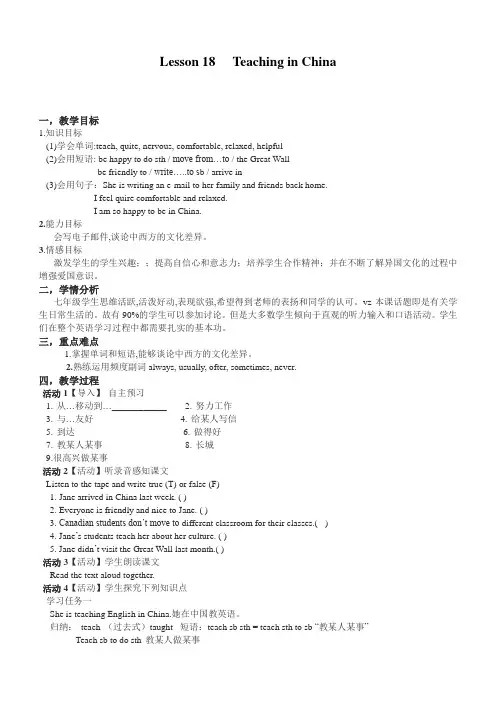
Lesson 18 Teaching in China一,教学目标1.知识目标(1)学会单词:teach, quite, nervous, comfortable, relaxed, helpful(2)会用短语: be happy to do sth / move from…to / the Great Wallbe friendly to / write…..to s b / arrive in(3)会用句子:She is writing an e-mail to her family and friends back home.I feel quire comfortable and relaxed.I am so happy to be in China.2.能力目标会写电子邮件,谈论中西方的文化差异。
3.情感目标激发学生的学生兴趣;;提高自信心和意志力;培养学生合作精神;并在不断了解异国文化的过程中增强爱国意识。
二,学情分析七年级学生思维活跃,活泼好动,表现欲强,希望得到老师的表扬和同学的认可。
vz本课话题即是有关学生日常生活的。
故有90%的学生可以参加讨论。
但是大多数学生倾向于直观的听力输入和口语活动。
学生们在整个英语学习过程中都需要扎实的基本功。
三,重点难点1.掌握单词和短语,能够谈论中西方的文化差异。
2.熟练运用频度副词always, usually, ofter, sometimes, never.四,教学过程活动1【导入】自主预习1. 从…移动到…____________2. 努力工作______________3. 与…友好___________4. 给某人写信______________5. 到达__________________6. 做得好_____________7. 教某人某事______________ 8. 长城____________________9.很高兴做某事____________活动2【活动】听录音感知课文Listen to the tape and write true (T) or false (F)1. Jane arrived in China last week. ( )2. Everyone is friendly and nice to Jane. ( )3. Canadian students don’t move to different classroom for their classes.( )4. Jane’s students teach her about her culture. ( )5. Jane didn’t visit the Great Wall last month.( )活动3【活动】学生朗读课文Read the text aloud together.活动4【活动】学生探究下列知识点学习任务一She is teaching English in China.她在中国教英语。
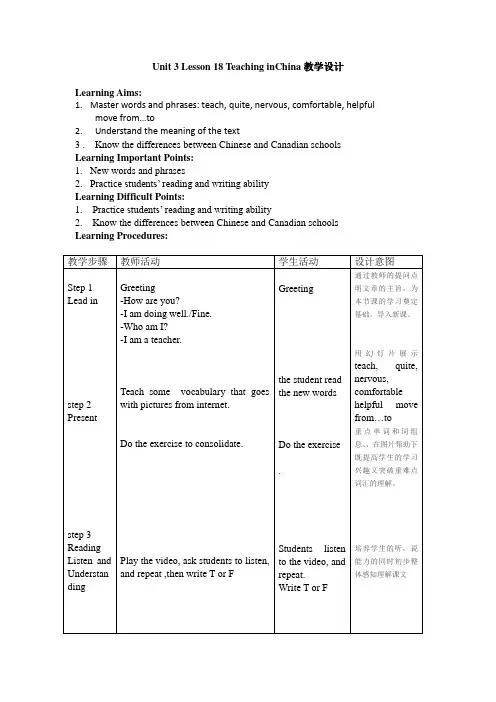
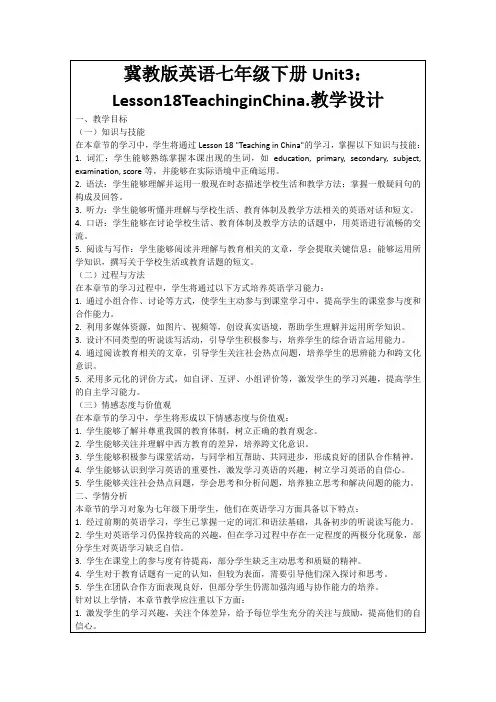
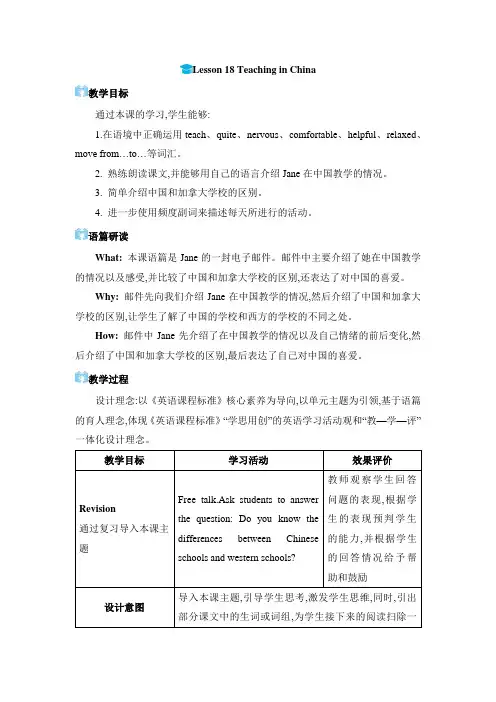
Lesson 18 Teaching in China教学目标通过本课的学习,学生能够:1.在语境中正确运用teach、quite、nervous、comfortable、helpful、relaxed、move from…to…等词汇。
2. 熟练朗读课文,并能够用自己的语言介绍Jane在中国教学的情况。
3. 简单介绍中国和加拿大学校的区别。
4. 进一步使用频度副词来描述每天所进行的活动。
语篇研读What:本课语篇是Jane的一封电子邮件。
邮件中主要介绍了她在中国教学的情况以及感受,并比较了中国和加拿大学校的区别,还表达了对中国的喜爱。
Why:邮件先向我们介绍Jane在中国教学的情况,然后介绍了中国和加拿大学校的区别,让学生了解了中国的学校和西方的学校的不同之处。
How:邮件中Jane先介绍了在中国教学的情况以及自己情绪的前后变化,然后介绍了中国和加拿大学校的区别,最后表达了自己对中国的喜爱。
教学过程设计理念:以《英语课程标准》核心素养为导向,以单元主题为引领,基于语篇的育人理念,体现《英语课程标准》“学思用创”的英语学习活动观和“教—学—评”一体化设计理念。
续表设计意图练习翻译句子,考查学生对本课重点单词或短语的掌握情况,以便有针对性地布置作业【应用实践】板书设计Lesson 18 Teaching in ChinaJane’s feelingsbefore: quite nervousafter: quite comfortable and relaxedDifferences between studentsChinese and Canadian schools teacherslanguages作业设计基础型作业:Finish Exercise 2 &3 on page 45.实践型作业:Retell the differences between Chinese and Canadian schools 教学反思。
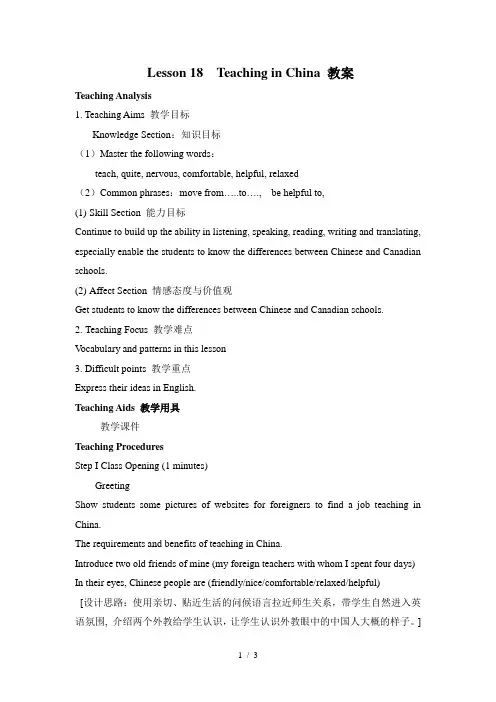
Lesson 18 Teaching in China 教案Teaching Analysis1. Teaching Aims 教学目标Knowledge Section:知识目标(1)Master the following words:teach, quite, nervous, comfortable, helpful, relaxed(2)Common phrases:move from…..to…., be helpful to,(1)Skill Section 能力目标Continue to build up the ability in listening, speaking, reading, writing and translating, especially enable the students to know the differences between Chinese and Canadian schools.(2)Affect Section 情感态度与价值观Get students to know the differences between Chinese and Canadian schools.2.Teaching Focus 教学难点V ocabulary and patterns in this lesson3. Difficult points 教学重点Express their ideas in English.Teaching Aids 教学用具教学课件Teaching ProceduresStep I Class Opening (1 minutes)GreetingShow students some pictures of websites for foreigners to find a job teaching in China.The requirements and benefits of teaching in China.Introduce two old friends of mine (my foreign teachers with whom I spent four days) In their eyes, Chinese people are (friendly/nice/comfortable/relaxed/helpful)[设计思路:使用亲切、贴近生活的问候语言拉近师生关系,带学生自然进入英语氛围, 介绍两个外教给学生认识,让学生认识外教眼中的中国人大概的样子。
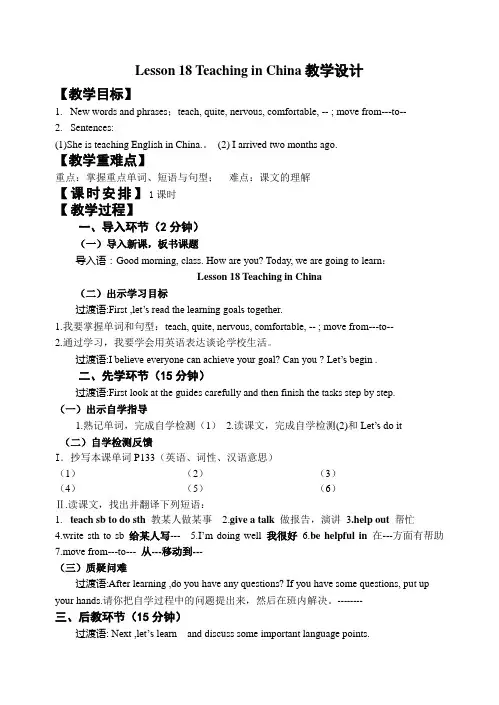
Lesson 18 Teaching in China教学设计【教学目标】1.New words and phrases;teach, quite, nervous, comfortable, -- ; move from---to--2.Sentences:(1)She is teaching English in China.。
(2) I arrived two months ago.【教学重难点】重点:掌握重点单词、短语与句型;难点:课文的理解【课时安排】1课时【教学过程】一、导入环节(2分钟)(一)导入新课,板书课题导入语:Good morning, class. How are you? Today, we are going to learn:Lesson 18 Teaching in China(二)出示学习目标过渡语:First ,let’s read the learning goals together.1.我要掌握单词和句型:teach, quite, nervous, comfortable, -- ; move from---to--2.通过学习,我要学会用英语表达谈论学校生活。
过渡语:I believe everyone can achieve your goal? Can you ? Let’s begin .二、先学环节(15分钟)过渡语:First look at the guides carefully and then finish the tasks step by step.(一)出示自学指导1.熟记单词,完成自学检测(1)2.读课文,完成自学检测(2)和Let’s do it(二)自学检测反馈I.抄写本课单词P133(英语、词性、汉语意思)(1)____________________(2)_____________________(3)__________________ (4)____________________(5)_____________________(6)__________________ Ⅱ.读课文,找出并翻译下列短语:1.teach sb to do sth教某人做某事2.give a talk做报告,演讲3.help out帮忙4.write sth to sb 给某人写---5.I’m doing well 我很好6.be helpful in在---方面有帮助7.move from---to--- 从---移动到---(三)质疑问难过渡语:After learning ,do you have any questions? If you have some questions, put up your hands.请你把自学过程中的问题提出来,然后在班内解决。
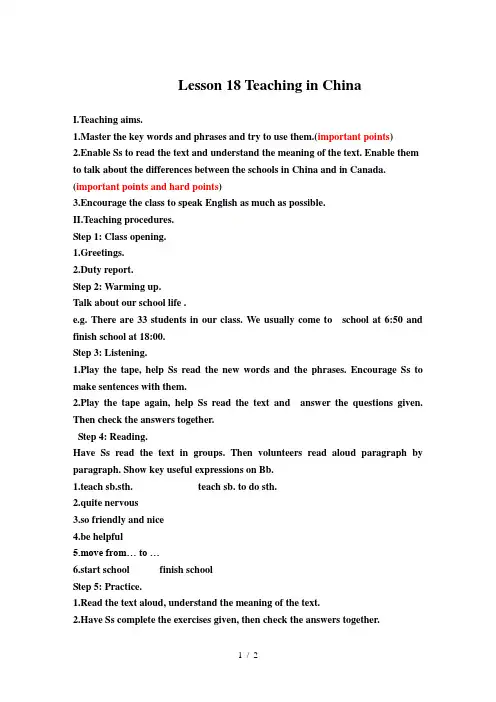
Lesson 18 Teaching in ChinaI.Teaching aims.1.Master the key words and phrases and try to use them.(important points)2.Enable Ss to read the text and understand the meaning of the text. Enable them to talk about the differences between the schools in China and in Canada. (important points and hard points)3.Encourage the class to speak English as much as possible.II.Teaching procedures.Step 1: Class opening.1.Greetings.2.Duty report.Step 2: Warming up.Talk about our school life .e.g. There are 33 students in our class. We usually come to school at 6:50 and finish school at 18:00.Step 3: Listening.1.Play the tape, help Ss read the new words and the phrases. Encourage Ss to make sentences with them.2.Play the tape again, help Ss read the text and answer the questions given. Then check the answers together.Step 4: Reading.Have Ss read the text in groups. Then volunteers read aloud paragraph by paragraph. Show key useful expressions on Bb.1.teach sb.sth. teach sb. to do sth.2.quite nervous3.so friendly and nice4.be helpful5.move from… to …6.start school finish schoolStep 5: Practice.1.Read the text aloud, understand the meaning of the text.2.Have Ss complete the exercises given, then check the answers together.Step 6: Summary.Step 7:Homework.1.Copy and recite the new words and phrases(3+1)2.Read the text aloud and understand the meaning of it.Blackboard design:Lesson 18 Teaching in Chinaeful expressions:1.teach sb.sth. teach sb. to do sth.2.quite nervous3.so friendly and nice4.be helpful5.move from… to …6.start school finish schoolII.Differences between schools in China and Canada:Schools in China: over 35 students; teachers move for classesSchools in Canada: only 35 students; students move for classesTeaching reflection:课堂中的每一个环节都应设计相应的练习题,让学生有目的的去说去听去做;课堂各环节连接紧凑,过渡自然;读的练习时间充足但对于知识的运用给的时间略少,以后需注意合理分配课堂时间。
七年级英语(冀教版)下册教学设计Unit3Lesson 18 Teaching in China一、教材分析本课主要以“在中国教学”这个话题为主线,通过用英语谈论学校的生活,表示自己的情感,介绍中国和西方国家学校生活的相同和不同之处,来展开教学活动。
二、学情分析我所教的班级是农村初级中学的普通班,大多学生的基础相当薄弱,水平不一,由于在小学英语课并未受到足够重视,学习态度虽有所好转,但整体惰性还是很强,自觉性很差,所以我在教学的过程中会尽量让所有学生都参与到活动中来。
三、教学目标让学生学会用英语谈论学习生活;用英语表达自己的情感;能用英语说出中国和西方国家学校生活的相同和不同之处。
使学生能保持浓厚的学习兴趣和正确的学习动机;并能在活动中积极与他人合作,互相帮助,共同完成学习任务。
四、教学重点难点1.词汇:teach quite nervous comfortable relaxed helpful2.短语:teach sb. sth.=teach sth. to sb. teach sb. to do sth.quite 作副词,意为“非常;十分”,与形容词或副词连用。
move from … to …be happy to do sth.visit +地点意为“参观某地”visit +sb. 意为“拜访某人”3.句型:1.I was quite nervous then.2.I feel quite comfortable and relaxed.3.My students are wonderful and the other teachers are always helpful.4.My students often teach me Chinese.五、教学方法任务教学法多媒体教学法六、教学媒体多媒体课件七、教学过程Step1 Present1. Teacher:How do you feel today?Students:I feel happy.Teacher:Please look back, your homeroom teacher is here, how do you feel now?Students:“Nervous.”Then teach the new words of this lesson.2. Do some exercise with the correct words of this lesson. Then check the answers.Step 2 ListeningListen to t he audiotape and complete Let’s Do It! No.1Step 3 Read and answerRead the text and answer some questions, then check the answers.Step 4 ReadingRead the text again and complete Let’s Do It! No.2.Step 5. Practice readingAsk the students to read aloud the text together.Step 6.Break it down.Point out some language points:1) teach sb. sth.=teach sth. to sb.teach sb. to do sth.2) quite 作副词,意为“非常;十分”,与形容词或副词连用。
Unit 3 Lesson18 Teaching in China教学目标:掌握词汇:teach, quite, nervous,comfortable,helpful接触词汇:relaxed掌握短语:move from…to重点:理解课文难点:中国和加拿大在教学上的区别教学过程:I词汇教学nervous friendly relaxed teach1.I don’t know anyone at the party. But everyone was very_______.2.Li Ming is going to give a talk. He is quite________.3.I’m a teacher. I________ music at a middle school.4.After a busy day, I like to sit and drink a cup of tea. It makes me feel________.II 听力Listen and write (T) or (F)1.Jane arrived in China last week. ( )2.Everyone is friendly and nice to Jane. ( )3.Canadian students don’t move to different classrooms for their classes. ( )4.Jane’s students teach her about their culture. ()III 阅读Read the lesson and answer the questions1.How do students in Canada have classes?2.What does Jane think of Chinese students?3. Where did Jane visit last month?IV 讨论中国和加拿大在教学上的区别V 写作给你的朋友写一封e-mail,告诉他中国和加拿大在教学上的区别。
Lesson 18: Teaching in China一:教材内容分析。
本课主要是通过一名外国教师Jane讲述自己在中国任教的一些感受,讲述自己在中国任教的快乐,并且表示自己热爱中国,也描述了中国教育和加拿大教育的不同,教育的不同也折射出中西方文化的不同,但文化没有好坏优劣之分,我们要热爱自己的文化,同事也要尊重其他国家的文化。
二:教学重、难点:重点:学习本课的词汇、句型。
难点:一般过去式三:教学目标1.知识与技能:(1)掌握词汇teach, quiet, nervous,comfortable, helpful(2)短语:be friend to…. be happy to do sth teach sb sth 2. 过程与方法:小组合作,学生自主探究学习3.情感态度与价值观:通过本课的学习让学生知道文化没有好坏优劣之分,我们要热爱自己的文化,同事也要尊重其他国家的文化。
四:学情分析七年级的学生,由于年龄小,又加上生性活泼好动,针对学生的现状,在课堂上尽量以鼓励表扬为主,注重培养学生学习的兴趣,营造学习的氛围,鼓励学生开口说英语,特别是给差生创造机会,让他们尝试成功的喜悦。
五:教法与学法设计Speaking and talking methodCommunication teaching method.六:教学环境及资源准备多媒体七:教学过程(1)互动交流,热身导入1.How many students in our class?2.Do we need to move from classroom to classroom for our classes?3.Are Canadian schools the same as ours?(2)听力训练,初步感知Listen to the tape and fill in the blanks.1.In Canada, there are usually only___ students in a class .2.They usually start school at 8;00a.m.and _____at 5;00p.m. (3)诵读课文,以读促知自读课文,完成阅读任务(1.判断正误2.补全句子3.回答问题4.回答问题5.翻译句子)1.Jane arrived in China last week.( )2.Everyone is so _____ and nice.3.Do Chinese students work very hard?4.How does Jane feel in China?5.I feel quite comfortable and relaxed._________组内读课文,找到下面的句子。
Lesson18 Teaching in China (冀教版)教学设计Lesson 18 Teaching in China.学习目标:★能够丰富并掌握有关校园生活的词汇.★★能够听懂有关于校园生活的对话.★★★能够运用有关于校园生活的词汇及其句型.阅读理解:1.自主快速阅读课文,回答三个小问题,初步感知课文内容,并集体交流答案,3分钟。
1)、Where is Jane from ? He is from Canada.2)、What is she teaching in China?She is teaching English.3)、Where did she go last month?She visited the Great Wall .2.师友自主细读课文判断正确的填T错误的填F,互助小组讨论,全班交流、纠正,3分钟。
1)Jane arrived in China last week.( ) 2)Everyone is friendly and nice to Jane. ( ) 3)Canadian students don’t m ove to different classrooms for their classes. ( ) 4)Jane’s students teach her about their culture. ( )3.根据课文内容找到加拿大学校与中国学校的不同。
先自主完成,再师友互助交流,然后全班交流、补充,3分钟。
China The teachers move from classroom to classroomfor classes.There are only 35 students in a class.{There are many students in a class, usually more than 35.Canada The students move from classroom to classroomfor classes.{III掌握生词:4.New words:默写下列单词,师友互助检查,3分钟。
Lesson 18 Teaching in China1.知识目标(1)学会单词: teach, quite, nervous, comfortable, relaxed, helpful(2)会用短语:1. be happy to do 2. move from…to 3.be friendly to4. write …..to sb 6.arrive in(3)会用句型:1. She is writing an e-mail to her family and friends back home.2. I feel quite comfortable and relaxed.3. I am so happy to be in China.2.能力目标会写电子邮件,谈论中西方的文化差异。
3.情感目标激发学生的学生兴趣;提高自信心和意志力;培养学生合作精神;并在不断了解异国文化的过程中增强爱国意识。
Lesson structure:Step 1 GreetingCheck the number of the students.Step2 ReviewCheck the text of last lesson. By translating the sentences1.We are talking about our study now.2.We hope to go to the moon someday.3.Don’t worry about my study. (同义句)。
4.Yao Ming is interested in playing basketball5.I learnt a lot about the history of China on the trip to the Silk Road.6.There are many different kinds of food in Huiyou supermarket.7.We are excited to hear the exciting news.8.I made a video about our sport meeting.9.There is a piece of paper.10.We won eighth place at our school sport meet. We did a good job.(let students translate the sentences to improve their spoken English.)Step 3 let students learn the learning goals.(Using the ppt)Step 4 Learn the new words (using the ppt)Step 5 ListeningListen to the tape and write T or F(Look at ppt)Step 6 Work in groups :Read the text twice and finish the task (Let’s do it)Step 7 Work in groups (come to Part 4)Step 8 What you have learnt.Step 9 Homework板书设计Lessons 18 Teaching in ChinaTeach quite nervous comfortable helpful Relax relaxed relaxingIn Canada , there are usually only 35 students in a class.I arrived two months agoAnd they move from classroom to classroom for their classes.They usually start school at 8:00 a.m. and finish at 5:00 p.m。